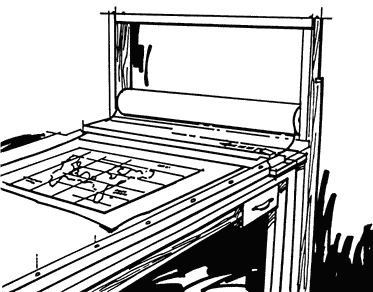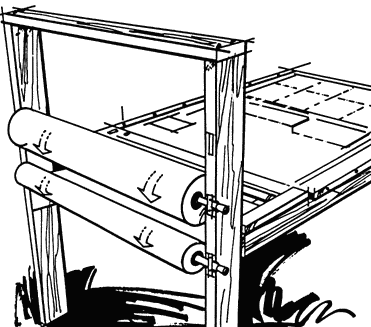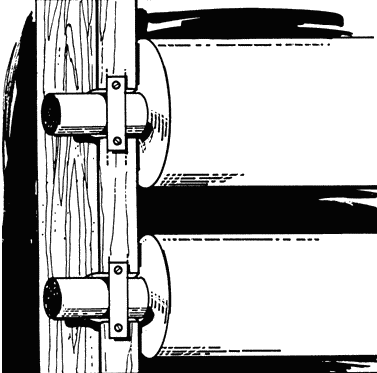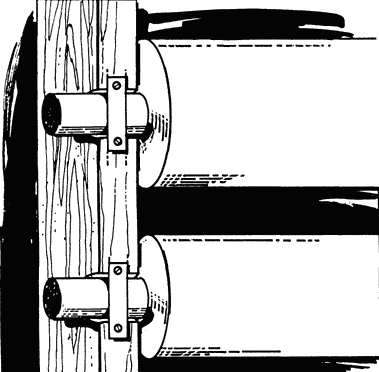

Gilderson-Duwe is Head of the Serials Department at Golda Meir Library, University of Wisconsin-Milwaukee; Matz furnished the illustrations and co-authored the text.
The American Geographical Society Collection (AGSC) at the UW-Milwaukee Golda Meir Library includes over 455,700 maps and charts. Many of the maps are too delicate to be used in their current condition. In an effort to make these maps usable, we employ a half-time person to mend and encapsulate these maps. Nonetheless, we have more items in need of preservation attention than we can keep up with. Because of this, we have tried to streamline the process of encapsulating.
Much has been written about the method of sealing the two pieces of polyester film together--some institutions are fortunate enough to have welders; most use double sided tape and I have read of a couple who sew the film together with cotton thread. But very little has been written about setting up a workstation to increase the ease of working with unwieldy rolls of film and oversized brittle items. Since in our situation the encapsulation technician works alone, we needed to set up a workstation that would enable her to quickly and easily manage the measurement and cutting of the film to the dimensions of the maps.
The AGSC Curator, Christopher Baruth, designed and built a workstation that has proven to fit our needs very well. We happen to use double-sided tape to seal the polyester, but since the workstation is designed for the cutting and fitting component of encapsulation, those who use other methods to affix the film could also benefit from this workstation design. We used materials that we already had at our disposal, so it was very inexpensive to construct. The plans below could be adjusted to suit your particular circumstances or to fit some of the supplies that you may have on hand.
Work Surface
Drafting table (We used a sturdy, old wooden table measuring: 3'
high x 3' 8" wide x 5' 11" long.)
Particle board--5' x 3' 11" x
3/4"
Plexiglas--1/4" x 3' 11" x 5'
2 pieces of wooden
edging: 3/4" x 1-1/2" x 5'
1/4" x 1" x 5'
Buff colored
paper, card stock weight--3' 11" x 5'
Mat cutter (we used
C&H Manufacturing, Super Deluxe, Model C#4060-A)
Dispensing unit
Two 2x6 boards cut to 3' 9" lengths
Three 2x6 boards cut to
5' 1-1/2" lengths
Three 1" dowels cut to 3' lengths
3 metal
brackets with screw holes on each end 1" x 3"
Work Surface

Begin by constructing the top of the encapsulation table. We made our work surface by bolting a sheet of particle board and a mat cutter to the top of an old wooden drafting table. The mat cutter is bolted to the end of the table that will be closest to the dispensing unit. Bolt the particle board snugly against the mat cutter and on top of the rest of the table (Figure 1). A sheet of Plexiglas is then placed on top of the particle board so that the height of the entire working surface is level. A single sheet of buff card stock is sandwiched between the Plexiglas and particle board. This helps to make the edges of the Mylar sheets more visible and reduces eye strain. In order to keep the Plexiglas from sliding off the table top, apply edging down the length of both sides of the work surface. The strip measuring 3/4" x 1-1/2" x 5' is bolted on to the top of the particle board along one side. This edge is therefore raised up above the surface of the Plexiglas and acts as a straight edge that is perpendicular to the cutter. This enables us to easily cut square pieces of polyester and paper. The second strip, measuring 1/4" x 1" x 5', is bolted to the opposite edge of the table with the edge of the strip flush with the top of the Plexiglas.
Dispensing Unit

The dispensing unit is a stand, similar in design to a paper towel holder, which holds rolls of Mylar and/or acid free paper and allows the material to be unrolled across the work surface (Figure 2). The dispensing unit is made by bolting one 2x6 board (measuring 3' 9") across the top of the two 2x6 boards (each measuring 5' 1-1/2") which are positioned vertically from the ground 3' 9" apart. A second 2x6 board measuring 3' 9" acts as a brace and is bolted to the side pieces in order to add strength and rigidity to the structure. This brace will be bolted to the work table, so its placement will vary depending upon the height of your table. Cut three notches (1 inch square) into the narrow edge of each vertical side board. They are positioned 2' 9" from the bottom, 3' 6" from the bottom and 4' 2" from the bottom (Figure 3). Metal brackets are screwed across the open side of the notches so that the dowels that hold the rolls of paper and polyester will stay firmly in place as the material is drawn off the rolls. Bolt the dispensing frame securely to the modified drafting table so that the notches face away from the work surface. Load the rolls onto the frame by threading a one inch dowel through it and then resting it inside the pre-cut notches.

In order to cut polyester film (or paper) to the desired length, the individual will stand to the left of the mat cutter, lift the arm of the cutter, firmly grasp the edge of the film and draw it out across the work surface to the desired length. The arm of the cutter is then closed over the film and the cutting knife is pushed away from the body to the opposite side of the work surface. Once this is accomplished, the polyester sheet should be cut off the roll and ready for further application (Figure 4).
Since many of the items that we encapsulate are not square, we cut the Mylar larger than the intended final product. After encapsulating the item, we cut the encapsulation down to size. This saves time in measurement, and we get a better fit to the piece.
